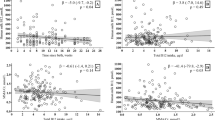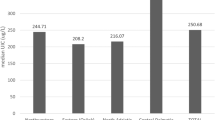Abstract
Objective: Because of known significant seasonal fluctuations of iodine concentration in cow's milk (ICM) in Switzerland (winter/summer (w/s) ICM ratio averages 5.6), we looked for seasonal variations and familial aspects in urinary iodine and sodium concentrations (UIC, UNaC).
Design: Prospective sequential cohort investigation.
Setting: University hospital.
Subjects: Thirteen children (six girls, seven boys) aged 3–10 y and their parents (n=9) aged 30–47 y.
Interventions: The volunteers collected 1729 spot urine samples (5.1996–5.1998). UIC data from winter (UICw: December–February) and summer seasons (UICs: July–September) were compared with UNaC and average milk consumption. Iodine intakes from milk and salt were modelized.
Results: Highest seasonal fluctuations of UIC were found in six pre-school children (w/s UIC group average=1.56, significant), followed by seven school children (w/s UIC group average=1.24, N.S.); none existed in adults. UIC/UNaC showed corresponding seasonal fluctuations in children, but not in adults. Winter milk was an important iodine source for children, as proven indirectly by similar seasonal fluctuations of ICM, UIC, UIC/UNaC and an important part within UIC due to milk.
Conclusions: Contribution to UIC from milk intake during winter was high in children (40–50%) and lower in adults (about 20%). Compared with children, dietary habits of adults are more complex and their iodine supply depends mainly on iodized salt and not on milk, so the effect of seasonal ICM variations on UIC is less marked. Because of significant seasonal UIC fluctuations in consumers of fresh milk products in Switzerland, results of future UIC studies conducted during summer and winter seasons should be compared cautiously, especially in young children. Furthermore, consumption of milk is to be promoted, since, besides calcium and vitamins, it is an essential source of iodine. UNaC determination should be included in epidemiologic studies if the dietary source of iodine is questioned.
Sponsorship: This work was supported by grants from the University Hospital in Bern, the Swiss Federal Office of Public Health, the ‘Swiss National Foundation for Scientific Research’ (32-49424.96), the ‘Fondation Genevoise de Bienfaisance V Rossi di Montelera’, the ‘Schweizerische Lebensversicherungs- und Rentenanstalt’ and the ‘Schüpbach Foundation of the University of Bern’.
This is a preview of subscription content, access via your institution
Access options
Subscribe to this journal
Receive 12 print issues and online access
$259.00 per year
only $21.58 per issue
Buy this article
- Purchase on Springer Link
- Instant access to full article PDF
Prices may be subject to local taxes which are calculated during checkout


Similar content being viewed by others
Notes
In Switzerland, this type of iodized salt is used for processed foodstuffs in view of commercial export and in sodium glutamate-containing flavouring preparations (‘Aromat’), widely used and very popular in households.
References
Als, C, Lauber, K, Brander, L, Lüscher, D & Rösler, H (1995). The instability of dietary iodine supply over time in an affluent society. Experientia (Basel), 6, 623–633.
Als, C, Keller, A, Minder, C, Haldimann, M & Gerber, H (2000a). Age- and gender-dependent urinary iodine concentrations in an area-covering population sample from the Bernese region in Switzerland. Eur. J. Endocrinol., 143, 629–637.
Als, C, Helbling, A, Peter, K, Haldimann, M, Zimmerli, B & Gerber, H (2000b). Urinary iodine concentration follows a circadian rhythm. A study with 3023 spot urine samples in adults and children. J. Clin. Endocrinol. Metab., 85, 1367–1369.
Anonymous (2000). Iodine in Milk, Food surveillance Information Sheet no. 198 London: MAFF
Broadhead, GD, Pearson, IB & Wilson, GM (1965). Seasonal changes in iodine metabolism. I. Iodine content of cow's milk. Br. Med. J., 1, 343–348.
Bürgi, H, Supersaxo, Z & Selz, B (1990). Iodine deficiency diseases in Switzerland one hundred years after Theodor Kocher's survey: a historical review with some new goitre prevalence data. Acta Endocrinol., 123, 577–590.
Bürgi, H, Portmann, L, Podoba, J, Vertongen, F & Srbecky, M (1999). Thyroid volumes and urinary iodine in Swiss school children 17 years after improved prophylaxis of iodine deficiency. Eur. J. Endocrinol., 140, 104–106.
Cordido, F, Vidal, J, Valino, D, Tunez, F & Jorge, S et al (1992). Diferente etiologia de la tiro-toxicosis en funcion de la prevalencia previa de bocio. Med. Clin. (Barc.), 99, 175–178.
Follis, RH, Vanprava, K & Damrongsakdi, D (1962). Studies on iodine nutrition in Thailand. J. Nutr., 76, 159–173.
Geigy Life Tables (1977). Wissenschaftliche Tabellen Geigy. Körperflüssigkeiten, 8th edn, pp95–98, Basle: Ciba-Geigy Ltd Switzerland
Haldimann, M, Zimmerli, B, Als, C & Gerber, H (1998). Direct determination of urinary iodine by inductively coupled plasma mass spectrometry using isotope dilution with iodine-129. Clin. Chem., 44, 817–824.
Haldimann, M & Zimmerli, B (1999). Preliminary results of an ongoing study to establish reference values for iodine concentrations in Swiss foodstuffs. Partly published inMitt. Gebiete Lebensm. Hyg., 90, 135–144.
Haldimann, M, Eastgate, A & Zimmerli, B (2000). Improved measurement of iodine in food samples using inductively coupled plasma isotope dilution mass spectrometry. Analyst, 125, 1977–1982.
Hollowell, JG, Staehling, NW, Hannon, WH, Flanders, DW, Gunter, EW, Maberly, GF, Braverman, LE, Pino, S, Miller, DT, Garbe, PL, DeLozier, DM & Jackson, RJ (1998). Iodine nutrition in the United States. Trends and public health implications: iodine excretion data from National Health and Nutrition Examination Surveys I and III (1971–1974 and 1988–1994). J. Clin. Endocrinol. Metab., 83, 3401–3408.
Jahreis, G, Hausmann, W, Kissling, G, Franke, K & Leiterer, M (2001). Bioavailability of iodine from normal diets rich in dairy products — result of balance studies in women. Exp. Clin. Endocrinol. Diabetes, 109, 163–167.
Koutras, DA, Papapetrou, PD, Yataganas, X & Malamos, B (1970). Dietary sources of iodine in areas with and without iodine-deficiency goiter. Am. J. Clin. Nutr., 23, 870–874.
Lamand, M & Tressol, JC (1992). Contribution of milk to iodine intake in France. Biol. Trace. Elem. Res., 32, 245–251.
Langford, NJ, Lewis, DJ & Crews, HM (2000). Iodine speciation in pasteurized milk and infant formulae. 10th Biennial National Atomic Special Symposium, 17–20 July (2000). Sheffield Hallum University, Abstract C23
Mordasini, C, Abetel, G, Lauterburg, H, Ludi, P, Perrenoud, JP & Schmit, H et al (1984). Untersuchungen zum Kochsalzkonsum der schweizerischen Bevölkerung. Schweiz. Med. Wochenschr., 114, 1924–1929.
Neubert, A & Remer, T (1998). The impact of dietary protein intake on urinary creatinine excretion in a healthy pediatric population. J. Pediatr., 133, 655–659.
Pennington, JAT (1990). Iodine concentrations in US milk: variation due to time, season, and region. J. Dairy Sci., 73, 3421–3427.
Pennington, JAT & Schoen, SA (1996). Total diet study: estimated dietary intakes of nutritional elements, 1982–1991. Int. J. Vit. Nutr. Res., 66, 350–362.
Preiss, U, Santos, CA, Spitzer, A & Wallnöfer, PR (1997). Der Jodgehalt der bayrischen Konsummilch. Z. Ernährungswiss., 36, 220–224.
Schällibaum, M (1991). Saisonale und regionale Schwankungen der Jodkonzentration in den Lieferanten-Milchproben. Schweiz Vereinigung Zuchthyg. Buiatrik., 103, 5
Schlotke, F & Sieber, R (1998). Berechnung des Verbrauchs an Nahrungsenergie, Energieträgern, Nahrungsfasern, Mineralstoffen, Vitaminen, und Spurenelementen. In:Vierter Schweizerischer Ernährungsbericht, pp18–27, Bern, Swiss Federal Office of Public Health
Sieber, R (1998). Verwendung von iodiertem Kochsalz bei der Käseherstellung. Ernährung, 22, 196–201.
Sieber, R, Badertscher, R, Bütikofer, U & Nick, B (1999). Beitrag zur Kenntnis der Zusammensetzung von schweizerischer pasteurisierter und ultrahocherhitzter Milch. Mitt. Gebiete Lebensm. Hyg., 90, 135–144.
Snyder, WS, Cook, MJ, Nasset, ES, Karhausen, LR, Parryhowells, G & Tipton, ICH (1975). Report of the Task Group on Reference Man., ICRP publication no. 23 Oxford: Pergamon Press
Solcà, B, Jaeggi-Groisman, SE, Saglini, V & Gerber, H (1999). Iodine supply in different geographical areas of Switzerland: comparison between rural and urban populations in the Bern and the Ticino regions. Eur. J. Clin. Nutr., 53, 754–755.
Spierto, FW, Hannon, WH, Gunter, EW & Smith, SJ (1997). Stability of urine creatinine. Clin. Chim. Acta, 264, 227–232.
Wenlock, RW, Buss, DH, Moxon, RE & Bunton, NG (1982). Trace nutrients 4: iodine in British food. Br. J. Nutr., 47, 381–390.
WHO/UNICEF/ICCIDD (1994). Indicators for assessing iodine deficiency disorders and their control through salt iodization, WHO/NUT 6, pp1–55, Geneva: WHO
Zimmerli, B & Knutti, R (1985). Untersuchungen von Tagesrationen aus schweizerischen Verpflegungsbetrieben. I. Allgemeine Aspekte von Zufuhrabschätzungen und Beschreibung der Studie. Mitt. Gebiete Lebensm. Hyg., 76, 168–196.
Zimmerli, B, Tobler, L, Bajo, S, Wyttenbach, A, Haldimann, M & Sieber, R (1995). Untersuchungen von Tagesrationen aus schweizerischen Verpflegungsbetrieben. VII. Essentielle Spurenelemente: lod und Selen. Mitt. Gebiete Lebensm. Hyg., 86, 226–265.
Zimmermann, MB, Hess, S, Zeder, C & Hurrell, RF (1998). Urinary iodine concentrations in swiss schoolchildren from the Zürich and Engadine valley. Schweiz. Med. Wochenschr., 128, 770–774.
Acknowledgements
We would like to thank the children and adult subjects for their valuable participation in the study, Mrs Murielle Groux and Mrs Nicole Laporte for analyzing urinary sodium and creatinine and Mrs Karin Blondeau-Dufossé of the Swiss Federal Office of Public Health, Division of Food Science for analysing urinary iodine.
Author information
Authors and Affiliations
Contributions
Guarantors: C Als, B Zimmerli and M Haldimann.
Contributors: CA had the initial idea, wrote and coordinated the project over several years. CA and BZ wrote the manuscript. MH and BZ did the calculations and the statistical evaluations. MH did the analyses of urinary iodine in his laboratory. All contributors helped in planning the study, evaluating the results and critically reading the manuscript.
Corresponding author
Rights and permissions
About this article
Cite this article
Als, C., Haldimann, M., Bürgi, E. et al. Swiss pilot study of individual seasonal fluctuations of urinary iodine concentration over two years: is age-dependency linked to the major source of dietary iodine?. Eur J Clin Nutr 57, 636–646 (2003). https://doi.org/10.1038/sj.ejcn.1601590
Accepted:
Published:
Issue Date:
DOI: https://doi.org/10.1038/sj.ejcn.1601590
Keywords
This article is cited by
-
Salivary iodine concentration in pregnant women and its association with iodine status and thyroid function
European Journal of Nutrition (2024)
-
Determinants of placental iodine concentrations in a mild-to-moderate iodine-deficient population: an ENVIRONAGE cohort study
Journal of Translational Medicine (2020)
-
Influencing factors on iodine content of cow milk
European Journal of Nutrition (2014)
-
Variations of urinary iodine during the first trimester of pregnancy in an iodine-replete area. Comparison with non-pregnant women
Hormones (2013)
-
Does a small difference in iodine status among children in two regions of Belgium translate into a different prevalence of thyroid nodular diseases in adults?
European Journal of Nutrition (2012)



